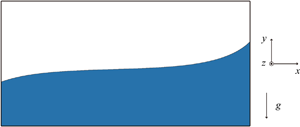Article contents
Capillary plugs in horizontal rectangular tubes with non-uniform contact angles
Published online by Cambridge University Press: 19 August 2020
Abstract

The aim of this paper is to make the formation of liquid plugs as difficult as possible in liquid partially filling a horizontal rectangular tube in a downward gravity field by setting the walls to have differing contact angles. Manning et al.'s method (J. Fluid Mech., vol. 682, 2011, pp. 397–414), extended from Concus–Finn theory, is applied to the existence of capillary plugs in rectangular tubes. The critical Bond numbers ( $B_c$) determining the existence of capillary plugs in a rectangular tube are studied for different settings of the non-uniform contact angles, and the influence of the aspect ratio (defined as the width-to-height ratio) of the rectangular cross-section on
$B_c$) determining the existence of capillary plugs in a rectangular tube are studied for different settings of the non-uniform contact angles, and the influence of the aspect ratio (defined as the width-to-height ratio) of the rectangular cross-section on  $B_c$ is examined. Compared to the maximum and minimum of
$B_c$ is examined. Compared to the maximum and minimum of  $B_c$ reached for uniform contact angles, the maximum of
$B_c$ reached for uniform contact angles, the maximum of  $B_c$ is higher, which is attained for the bottom contact angle
$B_c$ is higher, which is attained for the bottom contact angle  $\gamma _2=135^{\circ }$, the top contact angle
$\gamma _2=135^{\circ }$, the top contact angle  $\gamma _4=45^{\circ }$, and the side contact angles
$\gamma _4=45^{\circ }$, and the side contact angles  $\gamma _1=\gamma _3=90^{\circ }$; while the minimum is considerably lowered to zero, which is reached for
$\gamma _1=\gamma _3=90^{\circ }$; while the minimum is considerably lowered to zero, which is reached for  $\gamma _1=\gamma _2=45^{\circ }$ and
$\gamma _1=\gamma _2=45^{\circ }$ and  $\gamma _3=\gamma _4=135^{\circ }$. The aspect ratio of the rectangle has no influence on the maximum and minimum
$\gamma _3=\gamma _4=135^{\circ }$. The aspect ratio of the rectangle has no influence on the maximum and minimum  $B_c$ for a tube with walls of differing contact angles. There is only one non-occluded liquid topology in a square, while two topologies may occur in a rectangle with aspect ratio 2, and the transition between the two topologies is accompanied by a kink of the curve of
$B_c$ for a tube with walls of differing contact angles. There is only one non-occluded liquid topology in a square, while two topologies may occur in a rectangle with aspect ratio 2, and the transition between the two topologies is accompanied by a kink of the curve of  $B_c$. Optimization of the non-uniform contact angles can facilitate or effectively block the capillary plugs in rectangular tubes regardless of the aspect ratios.
$B_c$. Optimization of the non-uniform contact angles can facilitate or effectively block the capillary plugs in rectangular tubes regardless of the aspect ratios.
JFM classification
Information
- Type
- JFM Rapids
- Information
- Copyright
- © The Author(s), 2020. Published by Cambridge University Press
References
REFERENCES
- 14
- Cited by

